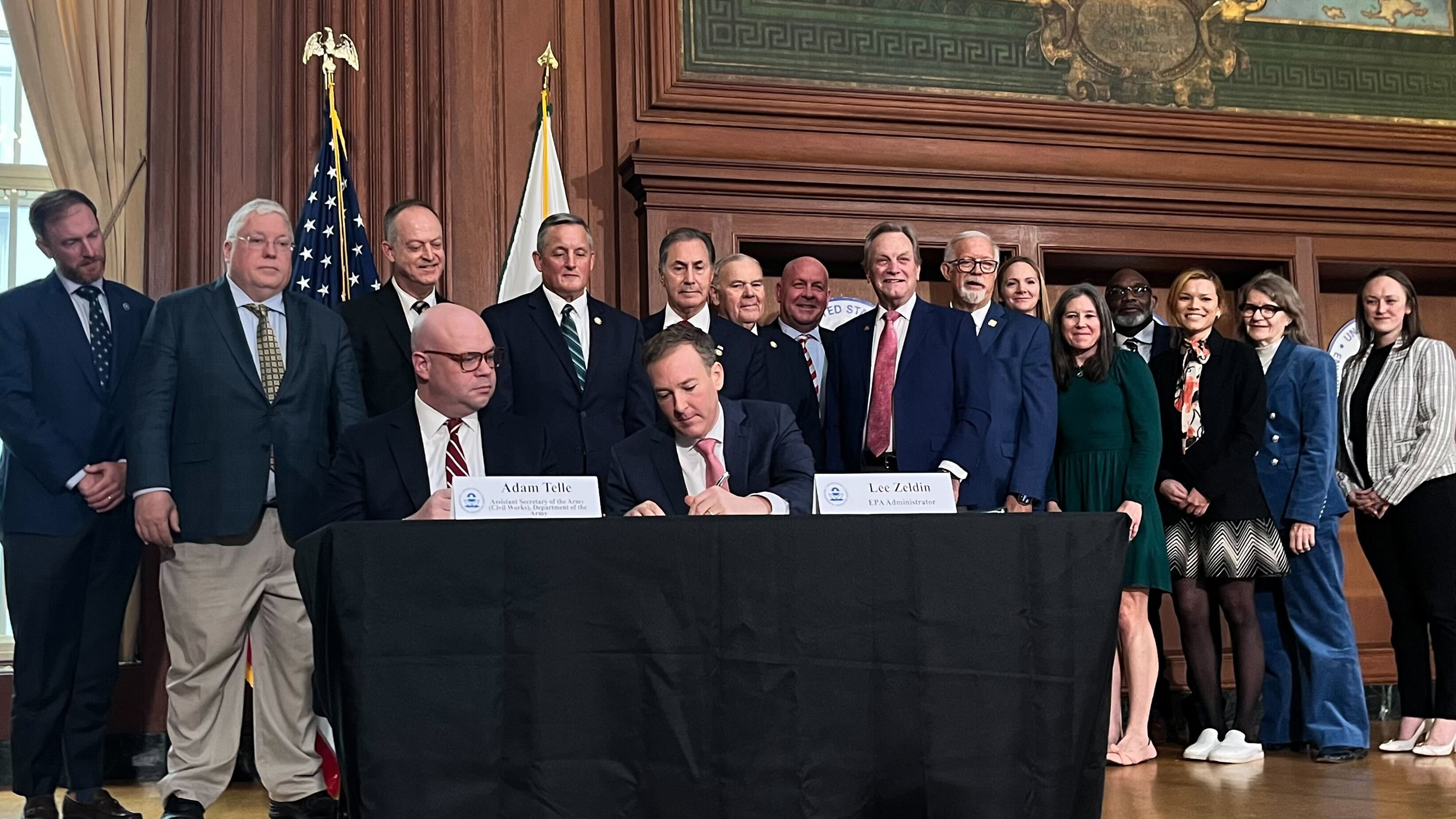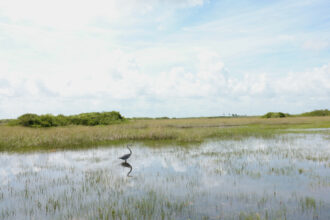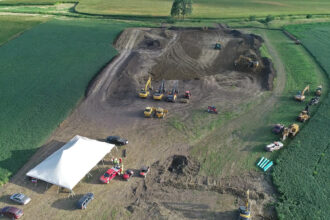The Environmental Protection Agency and the Department of the Army on Monday announced a proposal to further define, and scale back, the number of waterways and wetlands protected by the federal government under the Clean Water Act, a bedrock environmental law.
Flanked by supporters, including Republican members of Congress and West Virginia Gov. Patrick Morrisey, EPA Administrator Lee Zeldin signed the proposed rule in front of a packed audience at agency headquarters in Washington.
“News of today’s proposal is going to be met with a lot of relief from farmers, ranchers, other landowners [and] governments that have been looking for a simple, prescriptive definition that the whole country can operate off of,” Zeldin said at the signing.
According to a fact sheet released by the agency on Monday, the proposal will impact the government’s definition of “waters of the United States,” commonly referred to as WOTUS, which defines the scope of federal jurisdiction over Clean Water Act permitting.
The proposed rule would exclude groundwater from the definition, and would no longer automatically protect interstate waters.
It would also significantly limit which wetlands and streams are protected under the Clean Water Act, according to the Natural Resources Defense Council, an environmental group. According to NRDC, that move would exclude many critical wetlands and seasonal streams that it says are essential for drinking water supplies, flood control and ecosystem health.
In an interview on Monday, RJ Karney, senior director of public policy at the National Association of State Departments of Agriculture, said that the move brings welcome relief to states and the agricultural sector.
“What this came down to was a recognition of ‘cooperative federalism,’” Karney said, referring to a “partnership between the federal government and states in the implementation of federal regulations.”
Karney also said that the proposed rule provides a boost to the agricultural industry by providing clearer definitions that make it easier to understand what bodies of water are or aren’t regulated under the Clean Water Act.
Industry groups similarly lauded Monday’s move as a return to a more state-based approach to water protection regulations.
“We applaud EPA and the [Army Corps of Engineers’] efforts to bring our nation’s job creators one step closer to relief from years of federal government overreach by offering a clear, durable ‘Waters of the U.S. rule,’” said the Waters Advocacy Coalition, whose members represent a variety of industries including mining, fossil fuel and agricultural groups.
However, environmentalists roundly decried the Trump administration’s proposal as a threat to water quality across the nation.
In a statement, the Natural Resources Defense Council said that the proposed rule would “dramatically narrow which waters are covered by federal safeguards, leaving many wetlands and headwaters vulnerable to pollution and destruction.”
“These waters are vital for filtering drinking water, reducing flood and drought risks, and sustaining wildlife—but under the planned rule, many of them would no longer be protected,” the NRDC said.
A geospatial analysis NRDC conducted this year found that between 38 to 70 million acres of wetlands are at risk of pollution or destruction under modeled scenarios similar to the changes included in Monday’s proposal, the group said in its statement.
This story is funded by readers like you.
Our nonprofit newsroom provides award-winning climate coverage free of charge and advertising. We rely on donations from readers like you to keep going. Please donate now to support our work.
Donate NowJon Devine, director of freshwater ecosystems at NRDC, also pushed back against the idea that states are in a better position to regulate water quality than the federal government.
“There are several things wrong with that claim,” Devine said in an interview with Inside Climate News.
“The first and most obvious is that a lot of waters aren’t contained within a state,” Devine said. “That allows for pollution on one side of a water body, or upstream in a water body, to contaminate folks on the other side or downstream—even if that state has really protective laws.”
Additionally, Devine said that about half of states have no protections outside of federal law—and that even in states with good laws, many of the state agencies that implement them are underfunded and have historically relied on federal agencies to assist with implementation.
For environmental advocates, the Trump administration’s move is the latest in a series of recent blows to the Clean Water Act.
In a ruling earlier this year, the Supreme Court ruled 5-4 in City and County of San Francisco v. Environmental Protection Agency to limit the EPA’s power to enforce Clean Water Act permits.
And in a 2023 decision in Sackett v. Environmental Protection Agency, the court ruled that the EPA’s ability to protect wetlands applied only to those that are indistinguishable from, and have a “continuous surface connection” to larger lakes, oceans, streams and rivers.
To J.W. Glass, EPA policy specialist at the Center for Biological Diversity, Monday’s announcement showed that the administration is willing to step even further beyond the 2023 Supreme Court ruling to restrict the federal government’s role in protecting water quality.
“This is EPA looking at Sackett in the narrowest possible lens, and looking at what a wetland means in the narrowest possible legal lens, in an effort to make sure that the largest swath of wetlands are no longer considered jurisdictional, i.e. protected under the Clean Water Act,” Glass said.
The EPA will accept public comments on the proposed rule for 45 days once it is published in the Federal Register, and is required by law to consider the public’s feedback before finalizing the rule.
About This Story
Perhaps you noticed: This story, like all the news we publish, is free to read. That’s because Inside Climate News is a 501c3 nonprofit organization. We do not charge a subscription fee, lock our news behind a paywall, or clutter our website with ads. We make our news on climate and the environment freely available to you and anyone who wants it.
That’s not all. We also share our news for free with scores of other media organizations around the country. Many of them can’t afford to do environmental journalism of their own. We’ve built bureaus from coast to coast to report local stories, collaborate with local newsrooms and co-publish articles so that this vital work is shared as widely as possible.
Two of us launched ICN in 2007. Six years later we earned a Pulitzer Prize for National Reporting, and now we run the oldest and largest dedicated climate newsroom in the nation. We tell the story in all its complexity. We hold polluters accountable. We expose environmental injustice. We debunk misinformation. We scrutinize solutions and inspire action.
Donations from readers like you fund every aspect of what we do. If you don’t already, will you support our ongoing work, our reporting on the biggest crisis facing our planet, and help us reach even more readers in more places?
Please take a moment to make a tax-deductible donation. Every one of them makes a difference.
Thank you,













